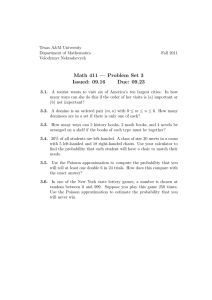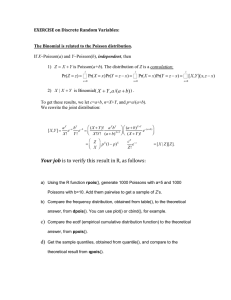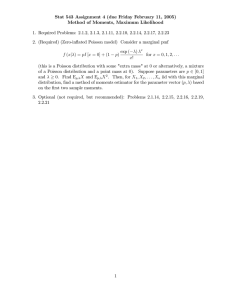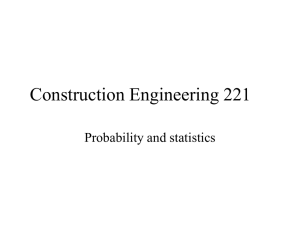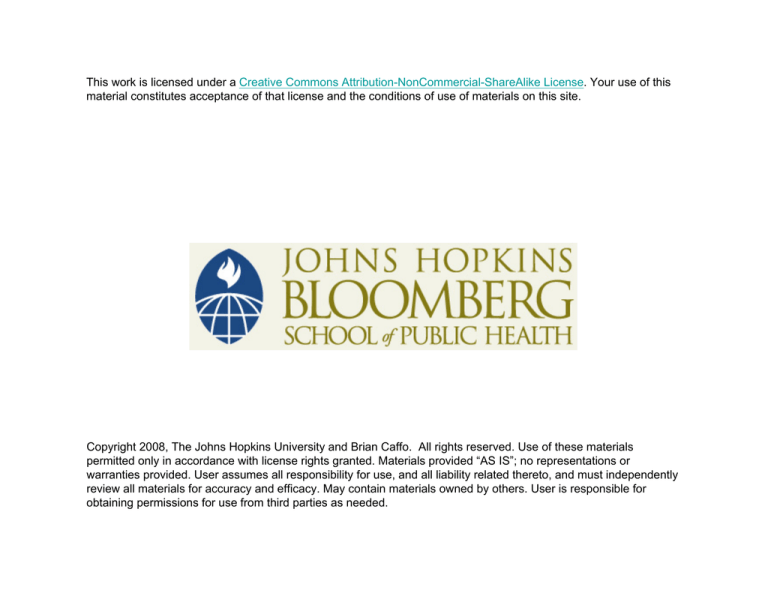
This work is licensed under a Creative Commons Attribution-NonCommercial-ShareAlike License. Your use of this
material constitutes acceptance of that license and the conditions of use of materials on this site.
Copyright 2008, The Johns Hopkins University and Brian Caffo. All rights reserved. Use of these materials
permitted only in accordance with license rights granted. Materials provided “AS IS”; no representations or
warranties provided. User assumes all responsibility for use, and all liability related thereto, and must independently
review all materials for accuracy and efficacy. May contain materials owned by others. User is responsible for
obtaining permissions for use from third parties as needed.
Lecture 27
Brian Caffo
Table of
contents
Outline
The Poisson
distribution
Poisson
approximation
to the
binomial
Person-time
analysis
Exact tests
Time-to-event
modeling
Lecture 27
Brian Caffo
Department of Biostatistics
Johns Hopkins Bloomberg School of Public Health
Johns Hopkins University
December 19, 2007
Lecture 27
Table of contents
Brian Caffo
Table of
contents
Outline
1 Table of contents
The Poisson
distribution
Poisson
approximation
to the
binomial
2 Outline
3 The Poisson distribution
Person-time
analysis
Exact tests
Time-to-event
modeling
4 Poisson approximation to the binomial
5 Person-time analysis
6 Exact tests
7 Time-to-event modeling
Lecture 27
Outline
Brian Caffo
Table of
contents
Outline
The Poisson
distribution
Poisson
approximation
to the
binomial
Person-time
analysis
Exact tests
Time-to-event
modeling
1
Poisson distribution
2
Tests of hypothesis for a single Poisson mean
3
Comparing multiple Poisson means
4
Likelihood equivalence with exponential model
Lecture 27
Pump failure data
Brian Caffo
Table of
contents
Outline
The Poisson
distribution
Poisson
approximation
to the
binomial
Pump
Failures
Time
1
5
94.32
2
1
15.72
3
5
62.88
4
14
125.76
5
3
5.24
Pump
Failures
Time
6
19
31.44
7
1
1.05
8
1
1.05
9
4
2.10
10
22
10.48
Person-time
analysis
Exact tests
Time-to-event
modeling
From Casella and Robert, Monte Carlo Statistical Methods;
first edition
Lecture 27
The Poisson distribution
Brian Caffo
Table of
contents
Outline
The Poisson
distribution
Poisson
approximation
to the
binomial
• Used to model counts
• The Poisson mass function is
P(X = x; λ) =
Person-time
analysis
Exact tests
Time-to-event
modeling
λx e −λ
x!
for x = 0, 1, . . .
• The mean of this distribution is λ
• The variance of this distribution is λ
• Notice that x ranges from 0 to ∞
Lecture 27
Brian Caffo
Table of
contents
Some uses for the Poisson
distribution
Outline
The Poisson
distribution
Poisson
approximation
to the
binomial
Person-time
analysis
Exact tests
Time-to-event
modeling
• Modeling event/time data
• Modeling radioactive decay
• Modeling survival data
• Modeling unbounded count data
• Modeling contingency tables
• Approximating binomials when n is large and p is small
Lecture 27
Brian Caffo
Definition
Table of
contents
Outline
The Poisson
distribution
Poisson
approximation
to the
binomial
Person-time
analysis
Exact tests
Time-to-event
modeling
• λ is the mean number of events per unit time
• Let h be very small
• Suppose we assume that
• Prob. of an event in an interval of length h is λh while the
prob. of more than one event is negligible
• Whether or not an event occurs in one small interval does
not impact whether or not an event occurs in another
small interval
then, the number of events per unit time is Poisson with
mean λ
Lecture 27
Poisson approximation to the
binomial
Brian Caffo
Table of
contents
Outline
The Poisson
distribution
Poisson
approximation
to the
binomial
Person-time
analysis
Exact tests
Time-to-event
modeling
• When n is large and p is small the Poisson distribution is
an accurate approximation to the binomial distribution
• Notation
•
•
•
•
•
λ = np
X ∼ Binomial(n, p), λ = np and
n gets large
p gets small
λ stays constant
Lecture 27
Proof
Brian Caffo
Table of
contents
Rice Mathematical Statistics and Data Analysis page 41
Outline
The Poisson
distribution
Poisson
approximation
to the
binomial
P(X = k)
=
=
Person-time
analysis
Exact tests
Time-to-event
modeling
=
n!
p k (1 − p)n−k
k!(n − k)!
k n!
λ
λ n−k
1−
k!(n − k)! n
n
n!
λ −k λk
λ n
× 1−
×
1−
n
k!
n
(n − k)!nk
→ 1×1×
=
λk −λ
e
k!
λk −λ
e
k!
Lecture 27
Notes
Brian Caffo
Table of
contents
Outline
The Poisson
distribution
Poisson
approximation
to the
binomial
Person-time
analysis
Exact tests
Time-to-event
modeling
• That (1 − λ/n)n converges to e −λ for large n is a very old
mathematical fact
n!
• We can show that (n−k)!n
k goes to one easily because
n!
1
2
k −1
= 1× 1 −
× 1−
×. . .× 1 −
n
n
n
(n − k)!nk
each term goes to 1
Lecture 27
Examples
Brian Caffo
Table of
contents
Outline
The Poisson
distribution
Some example uses of the Poisson distribution
Poisson
approximation
to the
binomial
• deaths per day in a city
Person-time
analysis
• teen pregnancies per month
Exact tests
• Medicare claims per day
Time-to-event
modeling
• cases of a disease per year
• homicides witnessed in a year
• cars passing an intersection in a day
• telephone calls received by a switchboard in an hour
Lecture 27
Some results
Brian Caffo
Table of
contents
Outline
The Poisson
distribution
• If X ∼ Poisson(tλ) then
X − tλ
X − Mean
√
=
SD
tλ
Poisson
approximation
to the
binomial
Person-time
analysis
Exact tests
Time-to-event
modeling
converges to a standard normal as tλ → ∞
• Hence
(X − tλ)2
(O − E )2
=
tλ
E
converges to a Chi-squared with 1 degree of freedom for
large tλ
• If X ∼ Poisson(tλ) then X /t is the ML estimate of λ
Lecture 27
Proof
Brian Caffo
Table of
contents
Outline
The Poisson
distribution
Poisson
approximation
to the
binomial
Person-time
analysis
• Likelihood is
(tλ)x e −tλ
x!
• So that the log-likelihood is
x log(λ) − tλ + constants in λ
Exact tests
Time-to-event
modeling
• The derivative of the log likelihood is
x/λ − t
• Setting equal to 0 we get that λ̂ = x/t
Lecture 27
Pump failure data
Brian Caffo
Table of
contents
Outline
The Poisson
distribution
• Failures for Pump 1: 5, monitoring time: 94.32 days
Poisson
approximation
to the
binomial
• Estimate of λ, the mean number of failures per day
Person-time
analysis
• Test the hypothesis that the mean number of failures per
Exact tests
Time-to-event
modeling
= 5/94.32 = .053
day is larger than the industry standard, .15 events per
day: H0 : λ = .15 versus Ha : λ > .15
√
• TS = (5 − 94.32 × .15)/ 94.2 × .15 = −2.433
• Hence P-value is very large (.99)
• HW: Obtain a confidence interval for λ
Lecture 27
Pump failure data
Brian Caffo
Table of
contents
Outline
The Poisson
distribution
Poisson
approximation
to the
binomial
Person-time
analysis
Exact tests
Time-to-event
modeling
• Exact P-value can be obtained by using the Poisson
distribution directly
• P(X ≥ 5) where X ∼ Poisson(.15 × 94.32)
ppois(5, .15 * 94.32, lower.tail = FALSE) = .995
very little evidence to suggest that this pump is
malfunctioning
• To obtain a P-value for a two-sided alternative, double the
smaller of the two one sided P-values
Lecture 27
Brian Caffo
Table of
contents
Outline
The Poisson
distribution
Poisson
approximation
to the
binomial
Person-time
analysis
Exact tests
Time-to-event
modeling
Pump
Failures
Time
λ̂
P-value
1
5
94.32
.053
.995
2
1
15.72
.064
.999
3
5
62.88
.080
.908
4
14
125.76
.111
.843
5
3
5.24
.573
.009
Pump
Failures
Time
λ̂
P-value
6
19
31.44
.604
1e-7
7
1
1.05
.952
.011
8
1
1.05
.952
.011
9
4
2.10
1.904
1e-5
10
22
10.48
2.099
2e-19
Lecture 27
Common failure rate
Brian Caffo
Table of
contents
Outline
• If Xi for i = 1, . . . , n are Poisson(ti λ) then
The Poisson
distribution
Poisson
approximation
to the
binomial
Person-time
analysis
Exact tests
Time-to-event
modeling
X
X Xi ∼ Poisson λ
ti
If you are willing to assume the common λ, then
contains all of the relevant information
P
Xi
• Clearly a common λ across pumps is not warranted.
However, for illustration, assume that this is the case
• Then the total number of failures was 75
• The total monitoring time was 305.4
• The estimate of the common λ would be 75/305.4 = .246
• Later we will discuss a test for common failure rate
Lecture 27
Person-time analysis
Brian Caffo
Table of
contents
Outline
The Poisson
distribution
Poisson
approximation
to the
binomial
Person-time
analysis
Exact tests
Time-to-event
modeling
OC
# of cases
# of person-years
Current users
9
2,935
Never users
239
135,130
From: Rosner Fundamentals of Biostatistics, sixth
edition, page 744
• One of the most common uses of the Poisson distribution
in epi is to model rates
• Estimated incidence rate amongst current users is
9/2, 935 = .0038 events per person year
• Estimated incidence rate amongst never users is
239/135, 130 = .0018 events per person year
Lecture 27
Poisson model
Brian Caffo
Table of
contents
Outline
The Poisson
distribution
Poisson
approximation
to the
binomial
Person-time
analysis
Exact tests
Time-to-event
modeling
• Rates are often modeled as Poisson
• Notice that the total number of subjects is discarded,
whether the 2,935 years was comprised of 1,000 or 500
people does not come into play
• Most useful for rare events (though we’ll discuss another
motivation for the Poisson model later)
• λ = .3 events per year
• Followed 10 people for a total of 40 person-years
• Expected number of deaths is .3 × 40 = 12, larger than
our sample
• λ is assumed constant over time
Lecture 27
Brian Caffo
Comparing two Poisson means
Table of
contents
Outline
The Poisson
distribution
Poisson
approximation
to the
binomial
Person-time
analysis
Exact tests
• Want to test H0 : λ1 = λ2 = λ
• Observed counts x1 , x2 Person-times t1 , t2
2
• Estimate of λ under the null hypothesis is λ̂ = xt1 +x
1 +t2
• Estimated expected count in Group 1 under H0
E1 = λ̂t1 = (x1 + x2 )
Time-to-event
modeling
t1
t1 + t2
• Estimated expected count in Group 2 under H0
E2 = λ̂t2 = (x1 + x2 )
t2
t1 + t2
Lecture 27
Notes
Brian Caffo
Table of
contents
Outline
The Poisson
distribution
Poisson
approximation
to the
binomial
Person-time
analysis
Exact tests
• Test statistic
TS =
X (O − E )2
E
=
(x1 − E1 )2 (x2 − E2 )2
+
E1
E2
follows a Chi-squared distribution with 1 df
• Equivalent computational form
Time-to-event
modeling
TS =
(X1 − E1 )2
V1
where
V1 = (x1 + x2 )t1 t2 /(t1 + t2 )2
Lecture 27
OC example
Brian Caffo
Table of
contents
Outline
The Poisson
distribution
Poisson
approximation
to the
binomial
Person-time
analysis
Exact tests
• x1 = 9, t1 = 2, 935
• x2 = 239, t2 = 135, 130
2,935
• E1 = (9 + 239) × 2,935+135,130
= 5.27
2,935×135,130
• V1 = (9 + 239) × (2,935+135,130)
2 = 5.16
Time-to-event
modeling
TS =
P-value = .100
(9 − 5.27)2
= 2.70
5.16
Lecture 27
Brian Caffo
Estimating the relative rate
Table of
contents
Outline
The Poisson
distribution
Poisson
approximation
to the
binomial
• Relative rate λ1 /λ2
• Estimate (x1 /t1 )/(x2 /t2 )
• Standard error for the log relative rate estimate
r
Person-time
analysis
1
1
+
x1 x2
Exact tests
Time-to-event
modeling
• For the OC example the estimated log relative rate is .550
• The standard error is
q
1
9
+
1
239
= .340
• 95% CI for the log relative rate is
.550 ± 1.96 × .340 = (−.115, 1.26)
Lecture 27
Exact test
Brian Caffo
Table of
contents
Outline
The Poisson
distribution
Poisson
approximation
to the
binomial
Person-time
analysis
Exact tests
• HW: Extend the above test to more than two groups
• Suppose that the observed counts were low
• We obtain an exact test by conditioning on the sum of the
counts
• That is, we make use of the fact that
Time-to-event
modeling
X1 | X1 + X2 = z ∼ Binomial
t1
,z
t1 + t2
Lecture 27
Alternate motivation for Poisson
model
Brian Caffo
Table of
contents
Outline
The Poisson
distribution
Poisson
approximation
to the
binomial
Person-time
analysis
Exact tests
Time-to-event
modeling
• Another way to motivate the Poisson model is to show
that it is likelihood equivalent to a plausible model
• We show that the Poisson model is likelihood equivalent
to a model that specifies failure times as being
independent exponentials
• Whenever the independent exponential model is
reasonable, then so is the Poisson model, regardless of
how large or small the rate or sample size is
• The likelihood equivalence implies that likelihood methods
apply
Lecture 27
Recall
Brian Caffo
Table of
contents
Outline
The Poisson
distribution
Poisson
approximation
to the
binomial
Person-time
analysis
• The likelihood is the density viewed as a function of the
parameter
• The likelihood summarizes the evidence in the data about
the parameter
• If X ∼ Poisson(tλ) then the likelihood for λ is
Exact tests
Time-to-event
modeling
L(λ) =
(tλ)x e −tλ
∝ λx e −tλ
x!
• When you have independent observations, the likelihood is
the product of the likelihood for each observation
Lecture 27
Likelihood equivalence with
exponential model
Brian Caffo
Table of
contents
Outline
The Poisson
distribution
Poisson
approximation
to the
binomial
Person-time
analysis
• Suppose there is no censoring (every person followed until
an event)
• We model each person’s time until failure as independent
exponentials: Yi ∼ Exponential(λ)
• Each subject contributes λe −yi λ to the likelihood
Exact tests
n
Y
Time-to-event
modeling
X λe −yi λ = λn exp −λ
yi
i=1
• Here n is the number of events and
P
yi is the total
person-time
• Same likelihood as if we specify n ∼ Poisson(λ
P
yi )!
Lecture 27
Brian Caffo
Table of
contents
Likelihood equivalence with
censoring
Outline
The Poisson
distribution
Poisson
approximation
to the
binomial
Person-time
analysis
• Suppose now that the study ended before events were
observed on some subjects
• Likelihood contribution for each event is λe −yi λ
• Likelihood contribution for each censored observation is
Exact tests
Time-to-event
modeling
Z
∞
P(Y ≥ yi ; λ) =
λe −uλ du = e −yi λ
yi
The contribution is this integral b/c we don’t really know
the event time for that person, only that it was later than
yi
Lecture 27
Brian Caffo
• Combining the censored and non-censored observations,
Table of
contents
Outline
The Poisson
distribution
Poisson
approximation
to the
binomial
Person-time
analysis
Exact tests
we have
(
)
Y
λe
−yi λ
(
×
non−censored i
)
Y
e
−yi λ
censored i
x events (and hence n − x censored observations)
!
n
X
x
= λ exp −λ
yi
Time-to-event
modeling
i=1
• x is the total number of events and
Pn
i=1 yi
is the total
amount of person-time
• This is exactly the same likelihood as modeling
X ∼ Poisson(λ
Pn
i=1 yi )

